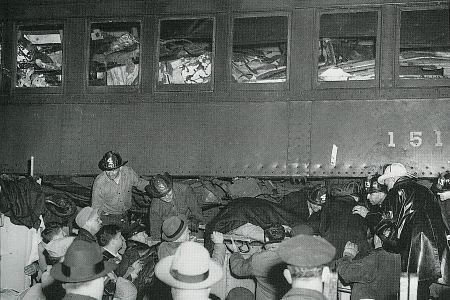
Friends, Neighbors Met Death Together in L.I.R.R. Rail Disaster [The Brooklyn Eagle, p. 10, cols. 5 - 6 (Nov. 24, 1950)] The home of Herbert E. Boepple of 83-11 125th St., Richmond Hill, became an emergency hospital. "They took my dining table out into the back yard and used it as an operating table", Mrs. Boepple said today. "I didn't go to bed at all, At 4 a.m. I was still making coffee for the rescue people." Her voice still quavered -- 36 hours after the crash. William Straker of 84-79 126th St., Richmond Hill, was one of the first at the scene. It happened just across the street from his home. "My house was police headquarters," he reported today. "The police were in and out phoning until 7 a.m. "Just when they left, the kids got up. They wanted to see what happened. I haven't been to bed yet." |

Click here to return to the main page.
[The following is excerpted from Keith Eastlake, , pp. 20 - 21 (Univ. Int'l Pty Ltd., Australia 1997)]
Richmond Hill,
New York State, USA
"Collisions at night are not an uncommon phenomenon on the world's railroads, as this incident which resulted in 79 deaths and 352 imjuries confirms. The crash in question involved a pair of 12-car electric trains. One was traveling from Penn station in New York to [Hempstead] station when a signal in the vicinity of the town of Jamaica indicated that it should reduce speed. However, when given the go-ahead to proceed as normal, the train's brake would not release fully.
The train shuddered to a halt because of the braking fault and, as the regulations demanded, the conductor [Ed. - It was the brakeman, not the conductor.] disembarked with a warning lantern to keep watch at the rear of the train. Because the signal system in use on this section of track did not permit a halted train getting under way to travel at more than 15mph (24km/h) when given the 'stop and proceed' signal until the next clear signal was seen, the conductor [brakeman] did not move any great distance down the track from his train. He expected that any following train would be obeying the same 15mph (24km/h) rule and would not, therefore, require as great a stopping distance as if it was moving at a much higher speed. It was to be an unfortunate but understandable miscalculation.
The conductor [brakeman] soon returned to the stopped train when he heard the driver [Ed. - In the U.S., a "driver" is called an"motorman".] attempting to move off. However, the train remained stationary because of the problem with the braking system. Moments later, the conductor [brakeman] had little time to do more than wave his red lantern in urgent warning as a second train loomed out of the darkness, advancing at high speed. Unable to brake in the available distance [it] plowed into the stationary train, driving it forward by some 25 yards (23m) and causing multiple casualties among the passengers on both trains.
It was later revealed that the second train had also received a 15mph (24km/h) 'stop and proceed' signal. Its driver [motorman] had followed the standard procedure correctly but then gradually picked up speed as he advanced. It was discovered that the second train was moving at 35mph (65km/h) when its driver [motorman] attempted to engage his locomotive's emergency brake in a futile attempt to prevent the accident from occurring.
The driver [motorman] in this following train was killed in the accident and investigators were never able to fully explain the reasons behind the increase in speed of the following locomotive that sealed the fate of the stationary train in front.
It was suggested that the second driver [motorman] had misinterpreted the clear signal that should have allowed the stationary train in front of him to proceed as normal had it been able. He may have thought that it was directed at him, not the train in front, and, therefore, allowed him to increase his speed to normal, thereby setting in motion the chain of events that led to the collision between the two."
Click here to return to the main page.